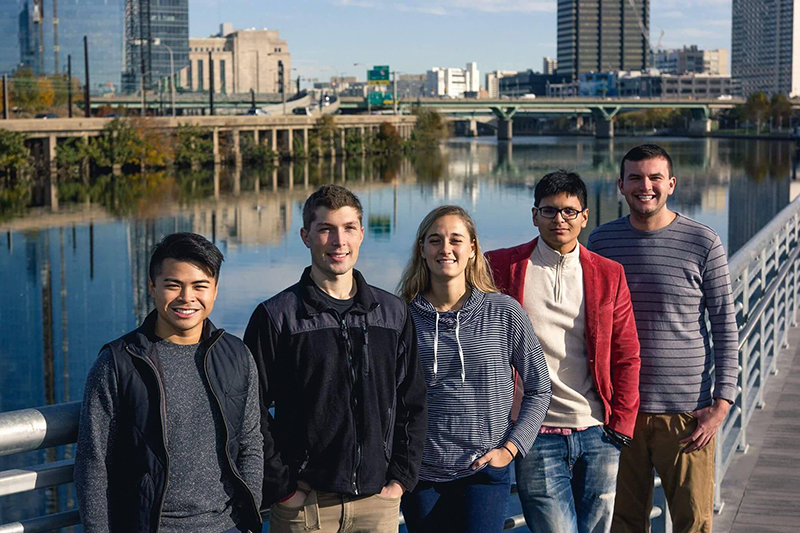By Lini S. Kadaba
 Like all good ideas, the MANTA came to life to solve a practical problem.
Like all good ideas, the MANTA came to life to solve a practical problem.
Daniel Diazdelcastillo ’17 was on his co-op at Hyperloop One in Los Angeles when he visited Long Beach, Calif., last summer [2016] and noticed pockets of trash in the water. He, being an engineer, immediately wondered if there is an autonomous system to clean up trash on water?
Before long, he had partnered with Aryaman Sinha ’17, Alexander Ly ’17, Elisabeth Wagner ’17 and Nicholas Philips ’17 for Senior Design Project, and the team, under the guidance of advisors Ani Hsieh, PhD and Tein Min Tan, PhD, decided to create, test and, fingers crossed, produce a device that would autonomously clean out floating trash from water bodies.
MANTA—Multipurpose Aquatic Navigator and Trash Annihilator—was born.
“I wanted to make a project on something that has not been done before or is very challenging to create or something that can have a wide impact on many people in the aerospace, renewable energy, robotics or automotive sector,” says Diazdelcastillo, 22, of Souther, Md., who is a mechanical engineering major like the others.
Sinha, 22, of Mumbai agreed. “The best thing about this project is that it is very engineering oriented but the problem it’s solving is environmental,” says the dual B.S./M.S. student. “It’s one step toward a cleaner environment.”
The system promises to work more efficiently than other devices and to help close the large gap between discarded plastics and recovery, Sinha says.
Its winged shape, like a manta ray with a rectangular box in the rear, creates minimum drag as it moves through water and funnels trash onto a conveyor belt and then into a shredder. The compacted waste then falls into the removable waste bin. MANTA’s navigation utilizes geo-fencing technology to coordinate the optimal path and avoid obstructions. Along with a strong propeller, the system maximizes speed. It also is environmentally friendly, using electric motors, not fuel, to operate.
“It’s a lot faster because of the design,” Sinha says.
In February, MANTA took second place in the inaugural Drexel University Libraries and College of Engineering PITCH Competition.
According to the group’s research, other water trash pickers exist. Baltimore City’s Water Wheel Trash Inceptor cleans the Inner Harbor but is stationary, with the harbor’s current moving debris to the wheel’s ravenous mouth. It wouldn’t do the job in stagnant water. The Netherlands uses the Waste Shark but it moves very slowly, Sinha says. In Philadelphia, skimmers such as the R.E. Roy patrol the Schuylkill for trash but require crew to collect litter.
MANTA offers an alternative. Creating a model and then prototype, though, is not cheap. In fact, funding the project is one of the biggest hurdles the group has faced. So far, MANTA has gotten grants totaling about $1,500 from ASTM International, the Mechanical Engineering Department, and has a GoFundMe page, Sinha says. The students have secured a provisional patent and hope to raise enough funds for the several thousand dollar utility patent before they graduate in June, he says.
However, the fundraising has fallen short. “We’ve been willing to pay for it out of our own pockets,” Sinha says. “but we’re still hoping for a sponsorship.”
“Our group is passionate about improving environmental health,” MANTA’s GoFundMe page says. “We’ve realized that one way to address the world’s growing pollution problem is to start right at the top—we want to tackle water debris.”
So far, the students have put a model through its paces in a lab water tank. By May, they hope to have a prototype that can be tested on the debris of the Schuylkill.
The project has stretched the group’s abilities. MANTA has a lot of electrical components, and that has forced the students to study up on electrical engineering through frequent visits to Drexel’s Electrical and Computer Engineering Department.
“They’ve been patient with us,” Sinha says.
The students spend hours a week on the project; Sinha alone says he rakes up 60 hours a week.
“I spend most of my time doing this,” says Sinha, who also is president of the Drexel chapter of the American Institute of Aeronautics and Astronautics. “We’ve made it a full-time hobby.”
For now, he could add. The goal is to develop a start-up, perhaps one successful enough to employ some of those in the group.
“All of us are very ambitious in different ways,” Sinha says. “We want to do something big, something that we would remember after we graduate.”